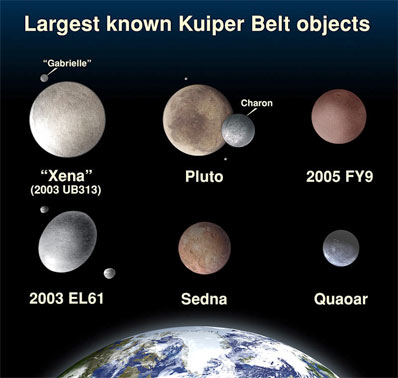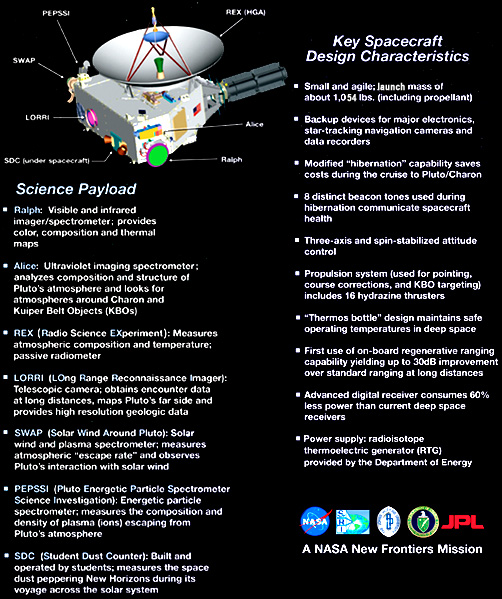To Pluto and the Kuiper Belt with New Horizons
I grew up like most of you with the certainty that our Solar System had nine planets revolving around the Sun. But Pluto, the ninth wasn’t discovered until 1930, nineteen years before I was born. And now that I am 63 we are back to before 1930 with eight planets. But we have added a new category called dwarf planets of which Pluto is one of possibly 1,000 or more. And Pluto is the object of New Horizons, a spacecraft launched in 2006 and arriving in the dwarf planet’s vicinity by 2015.
Pluto doesn’t look or act like any of its gas giant planet neighbours. Its orbit is not circular and is inclined at an angle that has it rising above and below the orbital plain of the other planetary bodies in the Solar System. It is so far away from the Sun that it is easier to describe the distances using a different measurement than kilometers or miles, in this case Angstrom Units or AUs. One AU equals the distance between the Earth and the Sun. When Pluto is closest to the Sun it is 30 AUs. When it is furthest away it’s 50 AUs from the Sun. When New Horizons arrives near Pluto in 2015, the dwarf planet will be approximately 31 AUs from the Sun and 4.8 billion kilometers (3 billion miles) from Earth. A message sent from New Horizons in 2015 will take four hours to reach us, more than two-and-a-half times longer than messages sent by Cassini from the vicinity of Saturn.
Other than the great distance and odd shaped orbit, what else do we know about Pluto? In size Pluto (2,274 kilometers, approximately 1,400 miles in diameter) is smaller than our Moon, Io, Europa, Ganymede, Callisto, Titan and Triton. Its surface bears a slight resemblance to Iapetus, the moon I described as bipolar in my blog about Cassini. Why bipolar because from Earth-based telescopes and Hubble we can see significant contrasts in light and dark features on the dwarf planet’s surface.
We have measured the surface temperature of Pluto at between -210 and -235 degrees Celsius (-346 to – 391 Fahrenheit). The axis of Pluto appears to be acutely inclined similar to Uranus. Composition appears to be a mixture of rock and water ice (70/30). We have identified nitrogen ice, solid methane, ethane and carbon monoxide in the brightest surface regions but have yet to figure out the surface composition of darker areas. Pluto’s tenuous atmosphere is believed to primarily consist of nitrogen as it is here on Earth with lesser quantities of methane and carbon monoxide. The atmosphere may freeze when Pluto is furthest away in its orbit but New Horizons will arrive while the atmosphere is in a gaseous state.
Charon, Pluto’s primary moon was discovered in 1978. It is unusually large as moons go when compared to Pluto with a diameter of 1,206 kilometers (approximately 750 miles). That makes it the largest moon in relationship to its companion of any Solar System object. Pluto and Charon rotate synchronously keeping the same face towards each other.
 The images above are of Kuiper Belt Objects, icy sub-planets that have only recently been discovered from Earth-based telescopes and the Hubble Space Telescope. Note that Pluto is today classified as a “dwarf planet” by scientific orthodoxy as are many other Kuiper Belt Objects. Source: The Encyclopedia of Science
The images above are of Kuiper Belt Objects, icy sub-planets that have only recently been discovered from Earth-based telescopes and the Hubble Space Telescope. Note that Pluto is today classified as a “dwarf planet” by scientific orthodoxy as are many other Kuiper Belt Objects. Source: The Encyclopedia of Science
New Horizon’s Mission Not Just Pluto
The mission to Pluto is a rendezvous and flyby. Why? because Pluto’s gravity is so low that entering orbit around it would be very difficult. The benefit of a flyby approach may be the opportunity to study other Kuiper Belt objects that New Horizons discovers after passing by Pluto. The Kuiper Belt resides outside the orbit of Neptune and is often described in similar terms to the Asteroid Belt between Mars and Jupiter. The difference, however, is the Kuiper Belt, first discovered in the mid-1990s, features many much larger objects that we classify as dwarf planets. See some of the more recently discovered ones in the illustration above. We think most Kuiper Belt objects consist of water ice and rock similar to Pluto. Our current estimates suggest the Belt is populated by at least 1,000 objects of which many can be classified dwarf planets. With odd-shaped orbits and orbital inclinations it will be a challenge for the mission team on Earth to find and image Kuiper Belt Objects let alone image Pluto in the faint sunlight of the outer Solar System. And to add to the mission tasks, when New Horizons launched Pluto was known to have a single moon. Since then Earth-based telescopes and the Hubble have identified three more. So that means trying to capture these new moons with on board cameras and sensors.
As in the Galileo and Cassini missions to Jupiter and Saturn, New Horizons has a payload of scientific instruments (see the image and table below) that include spectrometers, telescopes, infrared and ultraviolet imagers, magnetometers and other sensors. These will be used to study Pluto, its atmosphere, image and map its surface, study the interaction of the dwarf planet and its atmosphere with the solar wind and detect the presence or lack of a magnetosphere. With solar energy and light at a level 1/1,000th of space near Earth, New Horizons uses an RTG fuelled with plutonium dioxide to provide heat and power for the instrumentation.
While on its way to Pluto, New Horizons has been doing science in preparation for its ultimate destination. This has included a rendezvous with Jupiter, training its seven cameras and sensors on that planet and its four largest moons. The spacecraft has sent the first images of Pluto and Charon back to Earth as it has crossed the orbits of Uranus and Neptune. When it finally arrives in three years it will, as have all our other outer planet robotic spacecraft, alter our knowledge of the Solar System once again. We will learn more about the worlds of the outer Solar System and identify new Kuiper Belt Objects to add to our growing collection of neighbours.















